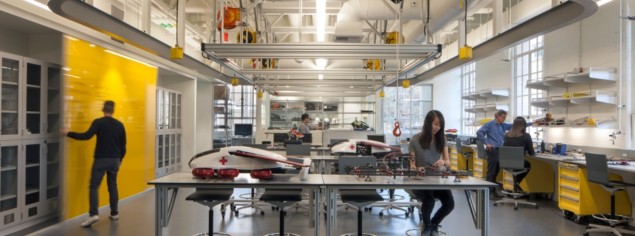
On Wednesday Sarah Tesh and I took some time out of the APS March Meeting to visit the California Institute of Technology, just a 20-minute ride away from downtown Los Angeles. The focus of our visit was the newly opened Centre for Autonomous Systems Technology (CAST), which brings together Caltech’s expertise in such fields as robotics, space and Earth exploration to build futuristic systems that can adapt and respond to their surroundings.
Mory Gharib, director of the CAST facility, told us that the centre is working towards five different “moonshots” – ambitious visions that help to inspire and direct the research effort. As an example, the “explorers” challenge seeks to build integrated systems – most likely a combination of flying, walking and swimming devices – that can navigate unfamiliar environments and react to emerging situations.
An important step towards that goal is to build bipedal robots that can walk on different terrains. Robotics expert Aaron Ames showed us the latest iteration, dubbed Cassie, which can control its own gait and balance to walk unaided around the Caltech campus. But Ames also showed us amusing videos that show even the newest R&D devices falling over when walking on compressible materials such as sand.
Gharib, meanwhile, is focusing his efforts on the “transporters” moonshot, which is in part is attempting to build flying ambulances that could act as a first response for injured people in hard-to-reach locations. “The battery technology is already good enough for us to fly a machine at 75 miles per hour for about 15 to 20 minutes,” he says. “That would be enough to get a person to hospital, or to remove people from dangerous situations, such as a fire.”
Gharib and his team have built a working model one-fifth the size of the final design, which would eventually be about the size of a Toyota Prius, and have tested it in a specially constructed wind tunnel that has an array of almost 1300 fans to generate real-world weather conditions with wind speeds of up to 44 mph. Vertical take-off remains an engineering challenge, but the biggest hurdle will be to make such flying systems truly autonomous. “They will need to survive and operate without human intervention,” Gharib explains. “We want them to interact with their surroundings and react accordingly.”
Gharib believes that the wind-tunnel tests will help to ensure that the flying devices can negotiate different weather conditions. “We are using human reactions as a leapfrog for our learning,” he says. “We use the wind tunnel to create different types of turbulence, and we monitor the reaction of a human operator to see how the machine can be kept on course. The output from the remote control, along with positioning data from a series of cameras, can then be used to train a machine learning system.”
Gharib admits that the vision of fully autonomous systems may not be realized for many years, but he believes that the moonshoot approach provides a powerful impetus for such interdisciplinary research. And despite having such an ambitious destination, he is confident that many useful technologies will emerge during the journey. “The moonshots are really a teaser to inspire and excite the scientists and students,” he says. “But the best fruit will be the technologies we develop along the way, just as the journey to the moon produced many of the technologies we use today.”
And if all this talk of thinking machines sounds a bit scary, Gharib stresses that Caltech’s intention is to create machines that work alongside us to achieve new things. “We need machines that help us discover new things,” he says. “Here at Caltech we want to create autonomous tools that will work as partners to help us do better science and engineering, and to do our jobs better.”



